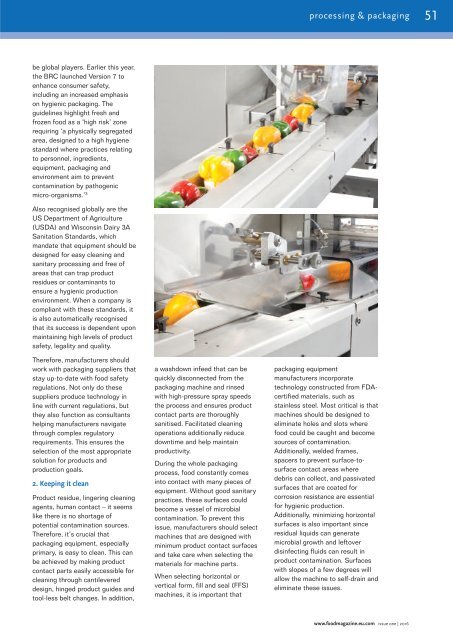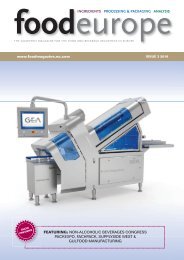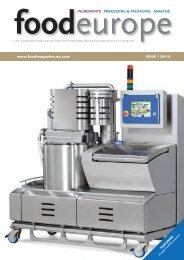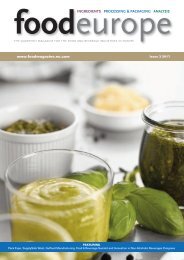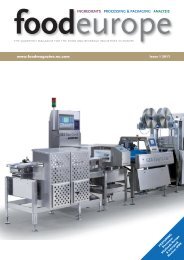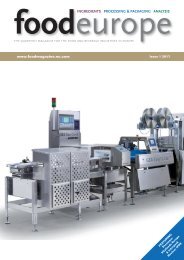Issue_1_2016
You also want an ePaper? Increase the reach of your titles
YUMPU automatically turns print PDFs into web optimized ePapers that Google loves.
processing & packaging 51<br />
be global players. Earlier this year,<br />
the BRC launched Version 7 to<br />
enhance consumer safety,<br />
including an increased emphasis<br />
on hygienic packaging. The<br />
guidelines highlight fresh and<br />
frozen food as a ‘high risk’ zone<br />
requiring ‘a physically segregated<br />
area, designed to a high hygiene<br />
standard where practices relating<br />
to personnel, ingredients,<br />
equipment, packaging and<br />
environment aim to prevent<br />
contamination by pathogenic<br />
micro-organisms.’ 3<br />
Also recognised globally are the<br />
US Department of Agriculture<br />
(USDA) and Wisconsin Dairy 3A<br />
Sanitation Standards, which<br />
mandate that equipment should be<br />
designed for easy cleaning and<br />
sanitary processing and free of<br />
areas that can trap product<br />
residues or contaminants to<br />
ensure a hygienic production<br />
environment. When a company is<br />
compliant with these standards, it<br />
is also automatically recognised<br />
that its success is dependent upon<br />
maintaining high levels of product<br />
safety, legality and quality.<br />
Therefore, manufacturers should<br />
work with packaging suppliers that<br />
stay up-to-date with food safety<br />
regulations. Not only do these<br />
suppliers produce technology in<br />
line with current regulations, but<br />
they also function as consultants<br />
helping manufacturers navigate<br />
through complex regulatory<br />
requirements. This ensures the<br />
selection of the most appropriate<br />
solution for products and<br />
production goals.<br />
2. Keeping it clean<br />
Product residue, lingering cleaning<br />
agents, human contact – it seems<br />
like there is no shortage of<br />
potential contamination sources.<br />
Therefore, it’s crucial that<br />
packaging equipment, especially<br />
primary, is easy to clean. This can<br />
be achieved by making product<br />
contact parts easily accessible for<br />
cleaning through cantilevered<br />
design, hinged product guides and<br />
tool-less belt changes. In addition,<br />
a washdown infeed that can be<br />
quickly disconnected from the<br />
packaging machine and rinsed<br />
with high-pressure spray speeds<br />
the process and ensures product<br />
contact parts are thoroughly<br />
sanitised. Facilitated cleaning<br />
operations additionally reduce<br />
downtime and help maintain<br />
productivity.<br />
During the whole packaging<br />
process, food constantly comes<br />
into contact with many pieces of<br />
equipment. Without good sanitary<br />
practices, these surfaces could<br />
become a vessel of microbial<br />
contamination. To prevent this<br />
issue, manufacturers should select<br />
machines that are designed with<br />
minimum product contact surfaces<br />
and take care when selecting the<br />
materials for machine parts.<br />
When selecting horizontal or<br />
vertical form, fill and seal (FFS)<br />
machines, it is important that<br />
packaging equipment<br />
manufacturers incorporate<br />
technology constructed from FDAcertified<br />
materials, such as<br />
stainless steel. Most critical is that<br />
machines should be designed to<br />
eliminate holes and slots where<br />
food could be caught and become<br />
sources of contamination.<br />
Additionally, welded frames,<br />
spacers to prevent surface-tosurface<br />
contact areas where<br />
debris can collect, and passivated<br />
surfaces that are coated for<br />
corrosion resistance are essential<br />
for hygienic production.<br />
Additionally, minimizing horizontal<br />
surfaces is also important since<br />
residual liquids can generate<br />
microbial growth and leftover<br />
disinfecting fluids can result in<br />
product contamination. Surfaces<br />
with slopes of a few degrees will<br />
allow the machine to self-drain and<br />
eliminate these issues.<br />
www.foodmagazine.eu.com issue one | <strong>2016</strong>


